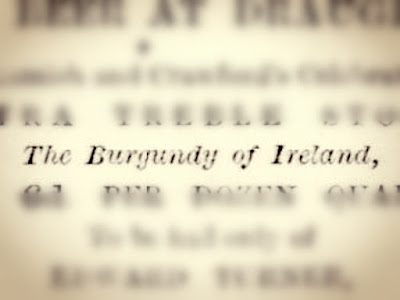But there was a nagging sense of something being wrong with this so I felt compelled to investigate it at some point, as that 'Burgundy' moniker was a little odd for a stout or porter. Stouts are dark red generally, but they are much darker than any burgundy I have partaken of - although that is not a very common occurrence to be fair. Also, I wondered how I had made the original blunder in assigning it to the Drogheda ale before changing it to the stout. (Thinking back now I possibly just associating the general quality and strengths of Burgundy wine to the XXX and did not focus too much on the colour.)
But time passed and other projects made me forget about this until quite recently when the term once again dropped into my brain and I decided to finally research it more. It did not take long for me to come across the following advertisement from The London Evening Standard from 31st July 1862, which predates the one above by a few months ...
And here is another from the same year in The Morning Post of the 1st of August that shows a variant of the same advertisement and you can see how it possibly led to the words being attached to the stout and not the ale from the way it was written and the faded brackets ...
Lastly here is a much clearer - if you squint - advertisement from The West Middlesex Advertiser from November of that same year where the attachment of the Burgundy name is clearly for the Drogheda Ale ...
These are obviously some of the advertisements I first read and that had originally stuck in my head. They clearly state that Drogheda Strong Ale is 'The Burgundy of Ireland' and I think the error came when the advertisement wording for these adverts was reused, communicated and rehashed perhaps, and the term was somehow assigned to the XXX stout instead. This makes sense in many ways as colour wise the strong ale was possibly a deep amber colour, as for example was a vintage amber ale produced by Smithwick's brewery at around this time which is mentioned in an article in The Waterford News and Star from September 1873. I have previously speculated that Drogheda ales were originally dark in colour and perhaps this is another pointer to that conclusion, but let us not jump too far on to the Irish Red Ale train just yet as there can be no comparison with the modern style and this old ale, although all of this might necessitate a new line or two in the middle part of my red ale trilogy. (The Drogheda Brewery Company mentioned in the first to adverts was Casey's brewery by the way.)
Admittedly, newspaper advertisements should not be taken as factual content in areas such as this, but my conclusion still seems to be the most accurate presumption - if one can be the other! It is also worth mentioning that in many cases these are the only records we have of certain beers, so we need to use them as reference points but with care and wariness.
As to the alcohol content I came across The Dublin Quarterly Journal of Science from 1862 that states that the abw (alcohol by weight) was 7% which would equate to 8.87% abv for Cairnes' Drogheda Ale according to this calculator. I am not sure how accurate that is but it would be relatively close and this strength would also help with its association with a wine, even if the colour would have been probably quite a bit paler.
Although there are certainly lessons to be learned all round here - especially by me - it is nice to see Drogheda Ale, which was held in such high esteem by many, getting such a nice reference.
Liam K.





No comments:
Post a Comment